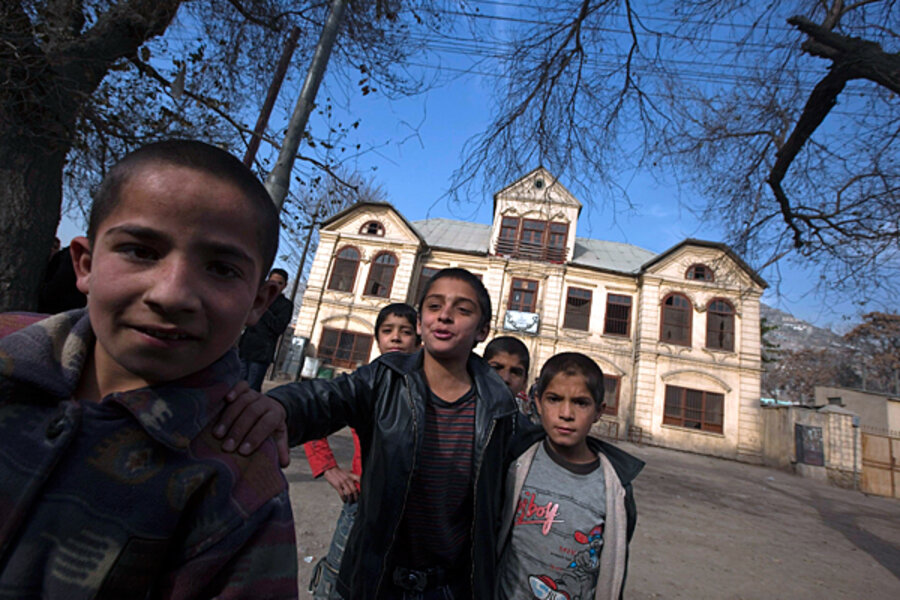Kabul 'safer' for kids than London or New York, says NATO official
Loading...
| New Delhi
The capital of war-torn Afghanistan is "probably safer" for children than New York City or London, says NATO’s top civilian representative in Kabul, despite Afghanistan being in the midst of a nine-year war.
Mark Sedwill made his original comments on a BBC children’s program airing today, responding to comments from Afghan children who said they were fearful of explosions.
“In Kabul and the other big cities, actually there are very few of those bombs. The children are probably safer here than they would be in London, New York, or Glasgow or many other cities. Most children can go about their lives in safety. It’s a very family-oriented society,” he said.
Children’s advocates, aid workers, and human rights campaigners challenged the statement – some connecting it to long-running concerns that the security bubble around top western officials in Kabul has blinded them to ground realities.
“I not only totally disagree with Mr. Sedwill’s assessment of child safety in Kabul, I’m amazed to see how oblivious and ignorant he is about this situation in Afghanistan,” says Ajmal Samadi, director of the Afghanistan Rights Monitor in Kabul.
“It means NATO [officials] have no idea what Afghanistan and Kabul is beyond their high compound walls. If he’s talking about NATO headquarters, yes, that’s safe,” he adds.
Poverty more deadly than war: Sedwill
Sedwill clarified his position in response to the outcry. "I was trying to explain to an audience of British children how uneven violence is across Afghanistan," he wrote in an e-mail statement.
"Half the insurgent violence takes place in 10 of the 365 districts and, in those places, children are too often the victims of IEDs and other dangers.
“But in cities like Kabul where security has improved, the total levels of violence, including criminal violence, are comparable to those which many western children would experience.”
Sedwill went on to say that challenges of poverty put “many more children at risk” than the war.
Kabul kids still at risk from bombs
Children have been caught in major explosions inside Kabul, however, including a 2007 bus bombing, the 2008 bombing of the Indian Embassy, and the 2009 bombing of NATO’s military mission (ISAF) headquarters. In the first half of 2010, 176 children were killed in conflict nationwide, a 55 percent jump from the same period last year.
While security has improved in Kabul Province this past year, it still saw 110 antigovernment attacks from January through September, according to the Afghanistan NGO Safety Office.
No reliable data on crimes affecting children exists in Afghanistan. But there are some vulnerability indicators.
Kabul has some 60,000 to 70,000 street and working children, according to Mohammad Yousef, director of the NGO Aschiana. “Early in the morning they go to the street, and at night they go back to family – that is not safe and secure,” says Mr. Yousef.
Some of these children suffer beatings at the hand of shopkeepers or police, adds Yousef; other times they are recruited as drug mules, fighters, or sex workers. The United Nations Children's Fund (UNICEF) data from 2005 found that nearly a quarter of all 13- to 14-year-old boys in Kabul are street children.
“These children do not have access to education. I think in the US and London there are opportunities for all children for education,” says Yousef. “If a child does not have access to education, he will not be safe and secure when he becomes an adult.”
Neither is school always a safe place. Scores of female students have wound up in the hospital following suspected poison gas attacks on schools in Kabul.
STORY: In Afghanistan, Drug Rehab for Children
UN: 1 in 5 die before age of 5
Even if such school incidents were actually a result of mass hysteria as suspected at the time, they point to Afghanistan’s massive psychological trauma from war. A 2004 survey in the Journal of the American Medical Association found post-traumatic stress disorder in more than 40 percent of respondents.
UNICEF “continues to regard Afghanistan as being one of the worst countries in the world to be a child.” Speaking of the country as a whole – not just Kabul – the UN agency noted that 1 in 5 children die before the age of 5, the worst infant mortality rate in the world.
Save the Children, meanwhile, calculates that 1 in 4 children in Afghanistan die before the age of 5. With Afghanistan's high fatality rates for infants and children, Save the Children in 2010 rated the central-Asian nation as the worst place in the world to be a mom, behind a string of poor African nations.
Sedwill’s 4-year-old daughter lives in London, points out Mr. Samadi of the Afghanistan Rights Monitor, asking: “Why doesn’t he bring his children to Kabul because it’s safer than London, obviously?”





